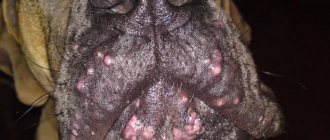Veronica Igorevna Sharipova
veterinarian Petstory
Kidney failure in dogs is a widespread disease throughout the world, which occurs regardless of standard of living and living conditions. According to statistics, about 15% of dogs over 10 years old suffer from kidney disease. Kidney disease ranks third among other causes of death in older animals.
What is this?
Renal failure (RF) is a pathological condition of the body in which the functioning of the kidneys is partially or completely impaired. This inevitably leads to problems with the excretory system, water-salt balance, blood circulation and blood pressure, as well as internal organs.
The risk group includes pets over 5 years of age (in the absence of provoking factors at an earlier age). In this case, you need to be especially careful if your dog belongs to one of the following breeds:
- shih tzu,
- samoyed dogs,
- english cocker spaniels,
- german shepherds,
- bull terriers,
- golden retrievers.
Kidney cells and tissues are not restored, so the diagnosis and treatment of the disease must be approached as carefully as possible, entrusting this task to experienced veterinary specialists.
Causes
In 20% of cases, the cause of kidney failure in dogs cannot be determined. This is due to the fact that owners do not know about possible provoking factors, and the disease is detected already in the last stages of development.
Among the most common reasons:
- Hereditary diseases
Amyloidosis and polycystic disease cause difficulty with kidney function in young dogs. This is caused by the accumulation of abnormal white structures and the formation of many cysts filled with fluid.
- Infections
Leptospirosis, Carré's disease, viral enteritis or hepatitis are just some of the acute infectious diseases that can trigger the development of kidney failure. This is due to the fact that pathogenic microorganisms penetrate the renal tissue, disrupting the functioning of the kidneys.
- Functional disorders
Certain diseases can cause kidney damage and pathological changes, provoking the development of renal failure. Among them: glomerulonephritis (glomerular nephritis), pyelonephritis, nephritis, nephrosis, etc.
- Parasitic infestation
Piroplasmosis and hemobarthenelosis destroy and also block the activity of red blood cells, exerting a toxic effect on the entire body as a whole. As a result of the release of toxins, the kidneys gradually lose functionality, so their work is disrupted.
- Intoxication of the body
Severe poisoning is a common cause of kidney failure among dogs of various ages and breeds. Most often it occurs when consuming household pesticides, medications, salts of heavy metals, etc.
- Diseases of the urinary system
The development of liver failure in dogs can be provoked by the most common disease of the urinary system - urolithiasis (UCD), since it is accompanied by compression or complete blockage of the urinary tract.
- Other reasons
Other factors can lead to kidney failure: benign and malignant tumors, cysts, severe bleeding with a sharp drop in blood pressure, congenital underdevelopment of organs, etc.
How does kidney failure manifest in dogs?
Detecting signs of kidney failure in dogs in the early stages is problematic. Typically, the first signs appear when about 65-70% of the kidney tissue is no longer functioning. The remaining part is not able to cope with the secretion and purification of blood, which entails various disturbances in the functioning of the body.
Signs of kidney failure in dogs:
- I (latent)
The longest period of development of renal failure. The animal's activity, mobility and appetite are normal. There are no abnormalities or symptoms of the disease. The disease can be diagnosed only by taking tests, since the level of creatinine in the blood will be no more than 125 mmol/l.
- II (compensatory)
The main signs are constant thirst and frequent urination. By the end of the compensatory stage, about 50% of the structural and functional units of the kidney (nephrons) die. The level of creatinine in the blood ranges from 125 to 180 mmol/l.
- III (decompensation)
Other signs are added to problems with urination: loss of appetite, sudden weight loss, constant weakness and lethargy, problems with the gastrointestinal tract. By the end of this stage, no more than 20% of nephrons are functioning. The level of creatinine in the blood is from 180 to 440 mmol/l.
- IV (terminal)
The most difficult period of illness, associated with severe intoxication of the whole body, electrolyte imbalance, and poor health. No more than 15% of nephrons continue to “work”, while the level of creatinine in the blood exceeds 440 mmol/l.
Diagnostics
As we have already noted, the primary stage of the disease does not have pronounced symptoms, and it is difficult to determine it using laboratory tests, since the kidneys are still doing their job well, despite the changes that have begun in them.
When the clinical stage approaches, a blood test for urea and creatinine reveals an increase in these indicators, and this is what makes it possible to understand that the dog has diseased kidneys.
If you have even the slightest suspicion that your pet has kidney problems, then you need to periodically take tests to determine the level of urea and creatinine and, if they approach the upper limit of the norm, discuss further actions with your veterinarian.
Forms of renal failure: acute and chronic
The nature of the manifestation of symptoms of renal failure in your pet depends directly on the form of the disease - acute or chronic. All signs differ in the brightness of the current and the speed of occurrence.
Chronic renal failure (CRF) usually occurs in adult dogs. It develops slowly but constantly. Before characteristic symptoms appear, the kidneys may lose 3/4 of their functions. The main symptom is extreme thirst, among other symptoms:
- ammonia odor from the mouth,
- dehydration,
- dry mucous membranes,
- dullness of fur,
- viscous saliva,
- decrease in body temperature to 37 °C,
- severe swelling,
- bradycardia,
- lack of appetite.
Note! The more nephrons are lost, the more severe the symptoms of kidney failure in dogs develop and manifest.
Acute renal failure (ARF) is characterized by the rapid onset of symptoms. It is clearly visible and complex, so the owner immediately notices that the dog’s condition has worsened. Among the main signs:
- a sharp deterioration in general condition,
- muscle weakness,
- urinary disturbance
- elevated heart rate,
- swelling,
- blanching/redness of mucous membranes,
- formation of ulcers in the mouth,
- complete refusal to eat.
Does your dog have a similar symptom pattern? Make an appointment with your veterinarian immediately. The sooner you seek professional veterinary help, the sooner your beloved pet will regain its appetite, mobility and good mood!
Symptoms of chronic kidney disease
Pathology cannot be detected at the very beginning, because there are no external symptoms at the initial stage if the disease is chronic. They appear only when one kidney stops functioning and the disease enters the clinical stage.
Symptoms can appear several at a time, or some individually.
Then clear symptoms appear:
If measures are not taken, the dog becomes dehydrated and urine disappears as a result.
Convulsions may begin, ulcers appear in the mouth, vomiting of undigested food and a coma, resulting in death.
Effective treatment
Treatment of acute and chronic renal failure in dogs is carried out in several directions. Regardless of the stage of the disease, infusion therapy (droppers) with medications that support the general functioning of your pet’s body is prescribed.
Note! Medicines and their dosage can only be prescribed by a veterinarian after an accurate diagnosis.
Drugs used:
- Infusion solutions (100-400 ml). They restore the balance of salts, alkalis and acids. They have a detoxifying, anti-shock and alkalizing effect. They are administered intravenously, but subcutaneous administration is allowed in puppies;
- Diuretics . Depending on the specific drug, the rate of fluid removal from the body is regulated by increasing/decreasing the Na concentration. They are used intramuscularly, intravenously or by drip;
- Antiemetic drugs . They soothe the gastrointestinal tract, relieving nausea and preventing vomiting. Quickly relieve vomiting symptoms. Used in solution or tablet format;
- Phosphorus binders . They are used to improve the condition of the stomach of dogs and have a sorbing effect. Some drugs have a pronounced detoxifying effect;
- Drugs to normalize cardiac activity . They are used if the functioning of the cardiovascular system has been impaired as a result of renal failure. The drugs stimulate the central nervous system, have an antiarrhythmic effect and tone up the heart.
Do not try to prescribe treatment for your pet at home. Only in a veterinary clinic will it be possible to restore the functioning of the kidneys and prevent the further development of acute or chronic renal failure!
- 1. What is kidney failure
- 2. How is kidney failure diagnosed in a Shar Pei?
- 3. Symptoms of hidden renal failure in Shar Pei
- 4. Clear signs of kidney failure
- 5. The diagnosis has been made...
- 6. Nutrition and Supplements (Opens in a new window)
- 7. Important to know (about medications)
- 8. Euthanasia (euthanization) of a dog in the terminal stage of chronic renal failure
- 9. The myth of healthy lines
From the author
This topic is a tribute to necessity, because more than once I have been asked to collect all the important information on this problem in one place in order to help confused owners act most effectively in the case when a dog is given a terrible diagnosis - chronic renal failure (CRF)
First, I want to warn all readers - I am not a certified veterinarian. All my knowledge in this area is the result of my own difficult experience as the owner of dogs who died from chronic renal failure, as well as the experience of friends and acquaintances with whom we studied this problem, trying to help their dogs prolong a relatively normal life before the inevitable end. My personal veterinary education includes two courses at the Moscow Veterinary Academy. Scriabin, so I am still quite knowledgeable about the anatomy and physiology of animals, which gave me the opportunity to delve quite deeply into the issues of maintenance therapy for chronic renal failure in Shar-Peis. A full-fledged co-author of this topic can be considered an amazing person - Mary Strauss, who was the owner of Shar-Peis for 25 years (the last two Shar-Peis lived with her for more than 16 years) and devoted the second half of her life to helping owners of sick dogs. At one time, her knowledge helped me. Now it's time to share them with others.
What is kidney failure in a Shar Pei?
Kidney failure is a pathological condition in which the kidneys partially or completely lose their functions. As a result, the biochemical composition of the internal environment of the body is disrupted. Non-volatile acids and nitrogenous metabolic products are retained in the body, an imbalance of water and salts, avitaminosis of water-soluble vitamins occurs, conditions arise for the development of failure of other organs - the heart, pancreas, liver, ulceration of the mucous membranes occurs, primarily the gastrointestinal tract, which leads to multiple stomach ulcers, bleeding gums, etc. A sustained decrease in kidney function by 70% or more leads to uremia - self-poisoning of the body with a fatal outcome.
There are acute and chronic renal failure. Acute renal failure (ARF) is characterized by a rapid onset, a relatively short cyclic course and often complete reversal. Severe acute renal failure can be irreversible and then inevitably becomes chronic. Chronic renal failure (CRF) usually begins unnoticed, develops gradually and has a progressive course; in the final stage of chronic renal failure, blood purification methods are used to prolong the patient’s life (and in people, kidney transplantation is performed).
Unfortunately, in most cases, chronic renal failure in Shar-Peis is diagnosed at the last stage, when any manipulations are already pointless (veterinarians understand this very well, but rarely refuse the owners’ request to “do at least something”).
“How could this happen? Just a few days ago my Shar-Pei was running, jumping, enjoying life and was completely healthy. And suddenly – such a terrible diagnosis!” I've lost count of how many times I've heard these words. Indeed, from the outside it looks as if someone suddenly turned off the light inside the dog. But this is a deceptive impression, behind which lies our inability to catch small signals of great trouble.
How is kidney failure diagnosed in a Shar Pei?
CRF cannot be cured. But the sooner it is detected, the greater the chance that the dog will live longer, despite the diseased kidneys. In order not to miss the onset of chronic renal failure, veterinarians, in particular Jeff Wiedt (who has been dealing with the problems of Shar-Pei for more than 20 years at the National Club in the USA), advise that simple diagnostic tests be carried out on all Shar-Pei, starting from the age of two years, at least once a year, and starting from 5 years - twice a year. What tests exactly are we talking about?
BLOOD TESTS Typically, creatinine and urea nitrogen levels are tested to diagnose kidney disease. Additionally, it is recommended to determine the following biochemical blood parameters: phosphorus, calcium and sodium/potassium ratio. A general blood test can also be informative, in particular the composition of red blood cells, platelets, leukocytes, lymphocytes and hematocrit.
CREATININE is the end product of protein metabolism. It is formed in the liver, then released into the blood, participates in the energy metabolism of muscle and other tissues, and is excreted from the body by the kidneys in the urine, therefore creatinine is a very important indicator of kidney activity. A high level of creatinine in the blood almost always means kidney problems. This does not indicate the nature of the problem - chronic or acute - and does not indicate its cause or how to solve it, but it does indicate that the dog has kidney problems and that action needs to be taken.
Normal values of creatinine in a dog’s blood are 26-120 µmol/l (according to some laboratory reference books, the upper limit of normal is 140 µmol/l). Please note that an increase in the level of creatinine in the blood can be facilitated by taking certain medications (as is usually written in the instructions for them), as well as by dehydration and mechanical damage to muscles. Creatinine is artificially reduced when taking corticosteroids (in some cases, this property of hormonal drugs is used by veterinarians to temporarily alleviate the intoxication of a dog with chronic renal failure). Early stage renal failure : An increase in creatinine of 140 to 200 µmol/L or slightly higher is considered to indicate moderate or early stage renal failure. Moderate renal failure : Creatinine values are between 200 and 398 µmol/L, but even at these values your dog may still not show any symptoms (other than increased water consumption and urination). Severe renal failure : creatinine above 398 µmol/l. This level of creatinine is usually accompanied by clinical symptoms such as vomiting and loss of appetite. Terminal stage : creatinine above 600 µmol/l. This level indicates that the kidneys have practically lost their functions, there is severe irreversible poisoning of the body with nitrogenous compounds and other “waste”, which are normally filtered and removed from the body by the kidneys. Death is inevitable and close.
UREA (sometimes “urea nitrogen”) is an active substance, the main product of protein breakdown, produced by the liver from ammonia and is involved in the process of concentrating urine. During the synthesis of urea, ammonia, a very toxic substance, is neutralized. Urea is excreted from the body by the kidneys. Accordingly, if urea is poorly excreted from the blood, this means a violation of the excretory function of the kidneys.
Normal blood urea values are 3.5-9.2 mmol/l. An increase to 12.5 mmol/L, if the dog has not fasted for 12 hours before the test, is not a cause for concern if other indicators (blood creatinine and urine specific gravity) are normal. Dehydration and stress can also contribute to increased urea levels. Initial stage of chronic renal failure: urea level up to 18 mmol/l. The dog can behave as if it were completely healthy. Moderate stage : urea up to 28 mmol/l. At this stage, the dog may refuse to eat, and it develops a specific smell of “urine” from its mouth. Severe stage : urea level above 28 mmol/l. This is evidence of uremia and is usually accompanied by clinical symptoms such as vomiting and loss of appetite. Terminal stage : urea above 50 mmol/l.
PHOSPHORUS and CALCIUM : As a rule, with progressive chronic renal failure, the calcium-phosphorus balance is disturbed. The phosphorus content in the blood increases, and calcium decreases. Increased phosphorus content is dangerous and requires control. Since calcium is the “building material” of bone tissue, poor healing of cracks and fractures in a dog may indicate hidden kidney problems.
SODIUM TO POTASSIUM RATIO : If the sodium/potassium ratio (sodium value divided by potassium value) in your dog's blood is below normal (27 or lower), it indicates Addison's disease (hypoadrenocorticism), which can cause kidney failure. Addison's disease can be fatal if left untreated, but it is treatable. It is often misdiagnosed as kidney disease, so it is worth further testing for this even if the sodium/potassium ratio is normal, especially in young bitches.
HEMATOCRIT (HCT) : a measure that reflects the proportion of red blood cells in the total blood volume. It determines whether the blood in the body is renewed. The lower the hematocrit value, the smaller the volume of red blood cells in the blood and the more plasma it contains. In simple language, this means that the blood “agees”, and the internal organs do not have time to create new red blood cells to replace the dying ones. This indicator is associated with kidney problems in this way: the kidneys are the main producer of erythropoietin, a hormone that stimulates the formation of red blood cells. Therefore, in case of renal failure, the production of erythropoietin sharply decreases, therefore, fewer red blood cells are produced, and their share in the total blood volume falls, as indicated by such an indicator as hematocrit.
URINE STUDY
DENSITY . A urine test may be important to diagnose kidney disease. Often the first sign of a dog's kidney problems is a low urine specific gravity (1.020 or lower). Moreover, this sign appears much earlier than the first deviations in blood tests. The greatest accuracy of the analysis is achieved if the “first daily urine” is taken for analysis, that is, when your dog urinates for the first time after night. If, with severe azotemia (high levels of urea and creatinine in the blood), the urine specific gravity remains normal (1.030 or higher), then this is a signal of prerenal (prerenal) problems such as Addison's disease, or postrenal problems such as urolithiasis (or nephrolithiasis) .
PROTEIN . Other signs of kidney disease may be the presence of protein in the urine, but a small amount of it, provided the specific gravity is high (1.035 or higher), is considered normal. Be aware that if urine is collected through a bladder catheter or manual stimulation of the bladder, there may be some blood in the urine, which will show up as traces of protein in the test. For this reason, it's best to test naturally occurring urine—simply use a scoop or small bowl to catch the urine when your dog urinates. If you do this at home, then immediately put the urine in the refrigerator, and then deliver it to the veterinarian as quickly as possible. It is best to allow the dog to start urinating before collecting urine to avoid introducing bacteria into the sample for analysis. The appearance of protein in the urine with normal blood counts may be the first signal of the onset of kidney problems. However, there can be many reasons for the appearance of protein in the urine. “When diagnosing kidney disease associated with protein loss, some of the most likely infections to keep in mind are: brucellosis, piroplasmosis, leptospirosis, boreliosis (Lyme disease), leishmaniasis, chronic bacterial infections and heartworms. Noninfectious causes include, but are not limited to, inflammatory bowel disease, systemic lupus, and hyperadrenocorticism (Cushing's disease)" (from Protein Losing Nephropathy: An Overview; by Bayer). There is a urine test called electrophoresis. This diagnostic tool allows you to understand the reason for the appearance of protein in the urine.
BACTERIA . Kidney disease (pyelonephritis) is often caused by urinary tract infections. Bacterial culture is the only way to rule out a urinary tract infection, as well as to find out what antibiotics need to be used to treat it, if detected. It is important that urine collection for bacterial culture is done according to all the rules in order to avoid “dirt” in the analysis. In some cases, the use of a catheter for these purposes is justified (this manipulation is carried out in the clinic, not at home).
ULTRASONIC DIAGNOSTICS (ultrasound)
Despite the fact that many veterinarians recommend ultrasound examination to monitor the condition of the kidneys, the value of ultrasound as a diagnostic method in dogs is highly questionable. Hand on heart, a diagnostic method in which you can confuse puppies with pyometra, not see 8 puppies at the end of pregnancy, see puppies where there are none (and all this is not the mistake of one specialist, but the results of ultrasound in different clinics, different dogs, at different times) causes mistrust. I personally know several dogs who died as a result of chronic renal failure, who had ideal or slightly different ultrasound results. Therefore, if we are not talking about diagnosing kidney stones, I consider it pointless to spend time and money on an ultrasound.
Symptoms of hidden renal failure in a Shar Pei
As I already said, most often owners discover chronic renal failure in dogs only when the dog is already in a severe or terminal stage. This happens because the dog does not know how to complain about attacks of malaise, about discomfort in some part of the body, and we often are not attentive enough to notice changes in its behavior, habits, eating habits, etc. The first rule of a good owner: do not wait until the dog shows obvious signs of illness, then it may be too late to do anything. If your dog is more than 3-4 years old, watch for the slightest deviations from its usual behavior. Maybe your dog began to sleep more, lie down more, or be less active? Or maybe she began to periodically arrange fasting days for herself, which was not the case before? Maybe she became less able to eat the food she liked? Or is she sad for no reason? Any deviations from the usual matter, since dogs are slaves of habits, and as long as everything is fine with them, they live and act according to the algorithm developed in childhood. If changes occur in it, do not hesitate to take your pet to the laboratory and have the blood and urine checked for possible abnormalities in kidney function. Dr. Jeff Widt recommends paying attention to creatinine and urea values even in cases where they do not yet exceed the norm, but are already very close to its upper limit. If the specific gravity of urine is no more than 1.020, then we can speak with a fair degree of confidence about the first signals of chronic renal failure. The same thing applies if protein is found in urine with normal urine density. In my practice, there was a case of so-called “isolated proteinuria” - a significant amount of protein in the urine, and at the same time completely normal blood tests and ultrasound. The dog in question died 9 months later from chronic renal failure.
Clear signs of kidney failure
Most often, sadly enough, owners come to their senses when the dog demonstrates one of the following (or all at once):
- refuses to eat, loses weight - drinks a lot and pees a lot (little) - began to make puddles at home - a smell similar to urine appeared from the mouth - incomprehensible attacks of vomiting and nausea appeared - fever - moves reluctantly, bends his back, cannot it's ok to sit or lie down
All these signs of malaise may indicate chronic renal failure in the moderate or severe (even terminal) stage.
The diagnosis has been made...
If this happens, the first thing you need to do is pull yourself together. There is no need to have any illusions about the prospects for “treating” chronic renal failure, especially if it is caught in the final stages. If the creatinine level is already above 600 µmol/l, and urea has exceeded 60 mmol/l, any manipulations with the dog will only prolong its days of painful illness. Unfortunately, few doctors and owners are stopped by the fact that there is nothing that can be done to help a dog with such tests and external symptoms or prolong life in the form in which the dog needs it (bed rest and life on IVs and on dialysis for a dog unnecessary and incomprehensible). At the same time, if you were sufficiently sensitive and attentive to your dog, and you managed to catch CRF at an early stage, you need, without panic and unnecessary emotions, with the help of an intelligent veterinarian, to develop an action plan to maintain the quality of life of your Shar-Pei. How to deal with progressive intoxication of the body, what medications to take, what to feed, etc. Your entire future life with your dog must be subject to strict rules: diet, taking the necessary medications, regular blood and urine checks
BLOOD PURIFICATION
A dog with chronic renal failure needs fluid therapy. Any experienced veterinarian knows this and, after making a diagnosis, prescribes a course of drips with saline and nutrients (glucose, cocarboxylase, etc.), as well as additional medications, depending on the severity of the disease and the depth of involvement of other internal organs in this process ( pancreas, liver, heart, gastrointestinal tract (GIT) suffer significantly in chronic renal failure). Intravenous infusions “feed” the body (especially if the dog hardly eats), supplying clean energy in the form of glucose, cocarboxylase, “wash” the blood, and nourish the tissues. And infusions (droppers) are a way to lower the level of urea and creatinine in the blood. However, if the level of these toxins in the blood is high, the effect of the IVs will most likely be negligible. In the moderate and severe stages of chronic renal failure, the most effective way to cleanse the blood of toxins that the kidneys stop removing is plasmapheresis. In the severe stage of chronic renal failure, this is practically the only way to radically and quickly cleanse the blood of a sick dog and thereby give it a little more time to live a normal life (as far as possible). Unfortunately, even in Moscow it is practiced in only one or two veterinary clinics.
Plasmapheresis (from the Greek “apheresis” - “removal”) is a modern, often uncontested, method of treating diseases of various organs and systems. The procedure consists of dividing the blood into cellular elements (erythrocytes, leukocytes, platelets, etc.) and plasma, i.e. the liquid part of the blood in which pathological and metabolic components are dissolved - carriers of the causes of diseases. The plasma is separated from the cellular elements and removed along with toxins and pathological elements; it is replaced in the body with various sterile solutions, and the cellular elements are returned to the patient.
The second effective method of blood purification after plasmapheresis is hemosorption. In the initial and middle stages of chronic renal failure, hemosorption sessions can help stabilize the condition of a dog with chronic renal failure at a more or less acceptable level, so that the dog can enjoy a normal life for some time.
Hemosorption (from hemo... and Latin sorbeo - I absorb), a method of extrarenal blood purification from toxic substances by pumping it through a column with a sorbent (activated carbon, ion exchange resins).
Hemodialysis is the most common method of blood purification in serious stages of chronic renal failure. It is also called an “artificial kidney device” and is widely used in people. As for use in dogs, in terms of effectiveness I would give it third place after plasmapheresis and hemosorption. It is curious that hemodialysis in humans is indicated in the terminal stages of chronic renal failure, when urea exceeds 30 mmol/l and creatinine exceeds 700 μmol/l. But many veterinarians believe that it is pointless to perform hemodialysis on a dog with such a high creatinine. At least, I know of cases of refusal to perform hemodialysis in dogs whose creatinine and urea levels corresponded to the terminal stage of the disease.
Hemodialysis (haemodialysis; Greek haima blood + dialysis decomposition, separation) is a method of extrarenal blood purification from substances with low and medium molecular weight by diffusion and partially convection (ultrafiltration). A procedure in which the patient's blood and dialysis solution are pumped from opposite sides of a semipermeable membrane towards each other. In this case, metabolic products pass through the membrane from the blood into the solution and are carried away by it. Excess fluid from the patient's body also passes through the membrane under the influence of the pressure difference created by the dialysis machine, which controls the procedure and ensures its safety.
Peritoneal dialysis is another way to cleanse the body of toxins that are not removed from it by the kidneys. It is considered to be technically simpler than hemodialysis and cheaper. In terms of actual effectiveness for dogs with chronic renal failure, based on the evidence collected, I would put it in 4th place.
Peritoneal dialysis (an. peritoneum peritoneum: Greek dialysis decomposition, separation) is a method of cleansing the blood and body from harmful substances, based on the high absorption capacity of the peritoneum (the serous lining of the abdominal cavity), in which the abdominal cavity is washed through special openings with medicinal solutions in large quantities
The owner of a Shar-Pei with chronic renal failure should remember that all these procedures do not provide a 100% guarantee of alleviating the dog’s condition and may have side effects on the heart. However, in a serious stage of chronic renal failure, without purifying the blood using one of these methods is the only chance to prolong the normal existence of the animal. Moreover, you will have to clean the blood and monitor its chemical composition on a regular basis, otherwise it’s better not to even start.
Nutrition and supplements
The diet of a dog with chronic renal failure is a separate big topic. Mary Strauss has an excellent collection of materials on the principles of selecting nutrition for a sick dog, which we publish with her consent in a separate large article.
It is important to know
If a dog suffering from chronic renal failure has elevated serum phosphorus levels, discuss with your doctor the need to use drugs that bind phosphorus, because its excess is dangerous and causes additional harm to the patient.
The most natural way to control phosphorus levels in the body is to consume calcium. If you are feeding your dog a home-cooked or raw diet, the easiest way is to add ground eggshells with a small amount of vitamin C to the food (1 teaspoon of dry ground eggshells from a raw egg contains an average of 2.2 mg of elemental calcium, the most digestible form, by the way). Moreover, it is worth doing this without waiting for the level of phosphorus in the blood to go beyond the normal range, i.e. for prophylactic purposes. The average dose per feeding is 1/2-3/4 teaspoon for every 0.5 kg of food.
The most effective phosphorus binder is aluminum hydroxide. It is familiar to many from the drugs Almagel, Maalox, etc., but aluminum hydroxide is preferable in its pure form, in gel form (for example, a drug with the trade name Aludrox). This drug should be used when phosphorus levels are clearly elevated, especially if calcium levels are also elevated.
Among the ready-made calcium preparations used to bind phosphorus, it is worth highlighting calcium acetate, since 40% less of it is needed to achieve the same result as when using calcium carbonate or calcium citrate. This is important when it comes to calcium use in a dog with normal or near elevated blood calcium levels. Approximate dosages for calcium acetate are 60 mg per kg of animal weight, for the other two forms - 100 mg per kg.
Do not use calcium complex preparations to bind phosphorus, since they usually also contain phosphorus.
All drugs that bind phosphorus should be given strictly during or immediately after meals to prevent excess phosphorus from entering the bloodstream from food.
The daily intake of calcium and phosphorus into the body of a sick dog should correspond to a 3:1 ratio.
Euthanasia
The most difficult and controversial question is to wait until a loved one dies on its own from pain and exhaustion, or to stop suffering when everything has been tried, and there is no longer a chance to prolong a normal life, and how to understand when this moment comes? There is a place in Switzerland where terminally ill, suffering people come with a one-way ticket. There they voluntarily die, breaking the chain of suffering that accompanies their illness. We don't give dogs that choice. But this does not mean that they do not suffer before death. Ask any competent doctor what kidney failure is in its final stage. People live on the strongest painkillers, in fact, drugs. Dogs don't get that either. When I hear from the owners “my dog wasn’t in pain, she quietly went away on her own, and I’m glad I didn’t have to euthanize her,” I want to ask - do you know what constant abdominal pain, persistent nausea, periodically ending with vomiting is? pieces of mucous mixed with gastric blood? Do you know what a terrible, dull, persistent headache is that you can’t escape? Do you know what it is like to have weakness all over your body, a dull pain in your joints all the time? Now put it all together - this is just about what a dog in end-stage CRF experiences. The Shar Pei is an amazingly patient creature. And the calmness, apathy, and drowsiness of a hopelessly ill dog does not mean that it is slowly and painlessly fading away from exhaustion. It's simply not common for dogs to moan and complain. They suffer in silence. It should not be forgotten that death from renal failure can be preceded by agony. If you refuse to euthanize a terminally ill dog in time, you risk finding yourself face to face with a terrible death, as happened to one of my friends: watching your beloved creature writhe and scream in pain was unbearable to such an extent that the owner grabbed the knife several times to kill her and stop the torment, the only thing stopping her was that she didn’t know how to do it for sure. Over the course of 12.5 years of living side by side with Shar-Peis, I had to resort to euthanasia with chronic renal failure three times. Two of those who left were elderly Shar-Peis picked up on the street, the third was a young female who received chronic renal failure as a result of an attack of acute renal failure. Therefore, I know well what I am writing about...
If the following signs of the terminal stage of chronic renal failure are visible: - the sick dog does not eat - drinks, but then vomits water with blood, and generally vomits frequently - practically does not move unless absolutely necessary, and during walks stands tall or lies on the ground - she is bleeding gums, and there is a very strong smell of urine from the mouth - the level of creatinine in the blood is above 800, urea - above 60 - if the dog cannot find a comfortable position to sleep
Believe me, there is no point or need to continue to “treat” a dying animal. The best thing you can do now is to give your beloved dog the opportunity to leave.
The myth of healthy lines
Owners of Shar Pei should understand one important truth: there are no lines that are healthy from kidney problems. Whether your dog will live to old age or die at 3-5 years old depends only on your personal luck. For example, an 8.5-year-old male lives and lives in my house, and his daughter died in my arms at 3.5 years old from kidney failure. And the point here is not how breeders conduct breeding work, but the fact that the genes that encode hereditary diseases are recessive and can be hidden for several generations in the genotype of healthy dogs. In addition, we do not have kennels that operate independently, without using dogs from other kennels. It is extremely rare that breeders can boast of pedigrees that include only dogs of their personal breeding going back several generations. This means that no breeder can give a 100% health guarantee to any of their puppies. By saying “we use dogs from healthy lines,” breeders are lying, wishful thinking, since in order to judge the health of the lines it is necessary to track the entire population, and not a few outstanding dogs from it. Not to mention that guaranteeing the health of other people's lines used in their breeding is a brave but stupid act. The level of breeding both in our country and abroad is not yet high enough for breeders to be frank with each other about problems with their dogs.
Nuances of nutrition in renal failure
Proper nutrition for a dog with kidney failure prevents the condition from worsening and the progression of the disease. It is recommended to exclude vegetable oils from the diet, while animal fats are not contraindicated. Vegetables should not be given raw: they must first be boiled and then crushed into puree.
It is necessary to exclude all foods rich in phosphorus:
- fish,
- bones,
- eggs,
- oatmeal,
- millet,
- barley,
- pumpkin,
- green beans, etc.
Kidney failure in a dog is a serious disease that remains virtually asymptomatic for a long time. To prevent dangerous consequences, it is recommended to periodically check with a veterinarian and conduct an ultrasound of the internal organs.
Timely treatment of renal failure will save your pet's life and provide reliable support for the functioning of the kidneys!
Caring for a sick dog
Caring for a sick pet mainly consists of proper nutrition and regular use of medications prescribed by the doctor.
The food must be balanced. You can use ready-made medications, but consult your veterinarian before doing so.
You can also cook yourself. The main food requirements: no salt and limited amount of protein. The water should be filtered, not tap water.
With proper treatment and care, the pet can live for a long time.
Meat products are good for dogs during the recovery period











